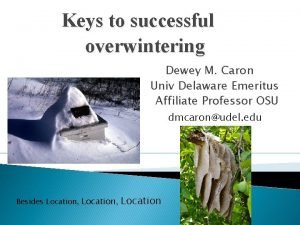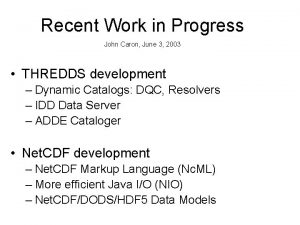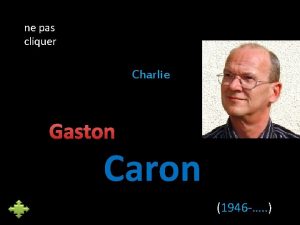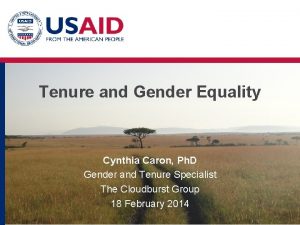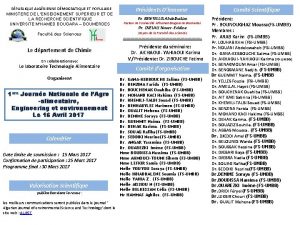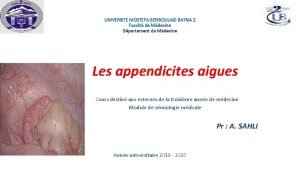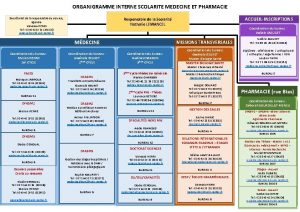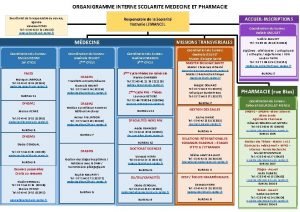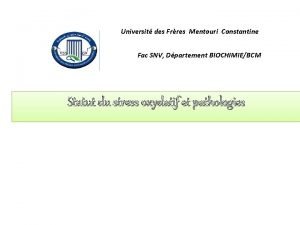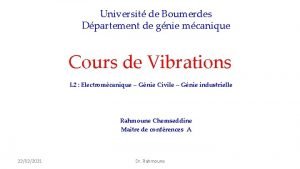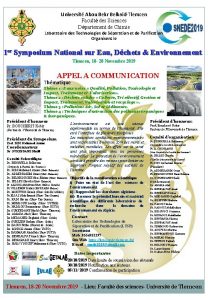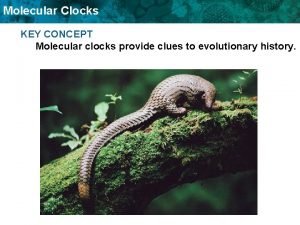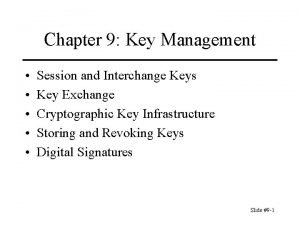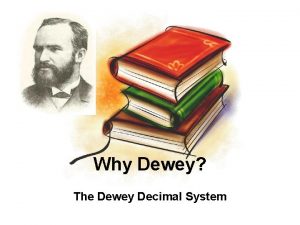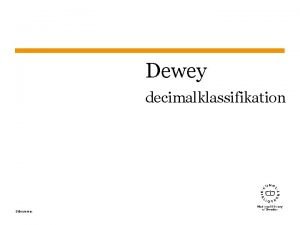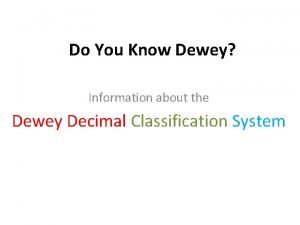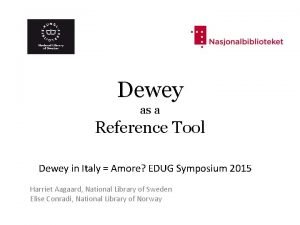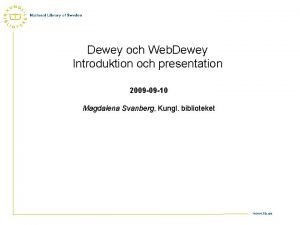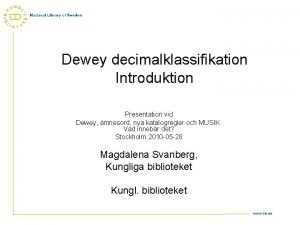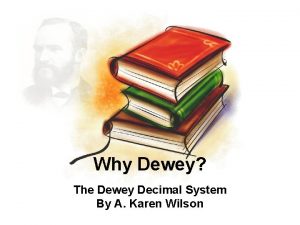Keys to successful overwintering Dewey M Caron Univ











































- Slides: 43

Keys to successful overwintering Dewey M. Caron Univ Delaware Emeritus Affiliate Professor OSU dmcaron@udel. edu Besides Location, Location

Seasonal perspective

What do successful Fall (and overwintered) colonies look like? � Strong populous colonies (BUT can they be too strong? ) � Young vigorous queens (why survivor or selected (hygienic)stock? ) � Healthy brood (lack PMS) and virus-free adults � Enough honey (how much is enough? ) and bee bread stores (how much is needed?

Some of the challenges � Apis mellifera -- Not native to US � Some regions (Oregon) with poor fall flow � Environment has ups and downs (Indian summer – early/late fall slow spring) � Bee mites, Bee Mites, � Mite BEE MITES relationship not a good one

Bees in decline � Honey bee colony health has declined since late 40’s � Accelerated decline in 90’s w/ bee mite increases � Mysterious syndromes - 2000 Bee PMS–CCD since 2007 Varroa mite HB tracheal mite CCD

In the beginning

Century+ of Disappearing Bees � 1869 – USA - IN, KY & TN � 1891&1896 - May Disease (Stonebrood (Aspergillus) � 1905 – 1919 Isle of Wight Disease � 1915 - Disappearing Disease Portland OR, � 1917 – Autumn Collapse Disease NJ NY OH Canada � 1963 – southern U. S. - Lou to Ca fall dwindling � 1975 - 27 US states & Mexico Pesticide Deaths – Indemnification 11 yrs � 1995 -96 NE & PA Epidemic � 2001 Bee PMS & 2007 CCD

8 year loss survey 2014 ~600, 000 col ~7200 indiv Acceptable Colony Loss level

2010 National Survey – 34. 4% Loss 32. 5% 73. 4% 31. 7% 10. 4%

2011 National Survey 29. 9% Loss 9. 5% 27. 2% 66%+ 64%

2012 National survey – 22. 5% loss 18. 5% 19% 25. 6% 27. 7%

2013 National survey - 30. 6% loss 22% TOTAL SEASON US=45. 2% - MA =58. 7% (160 indiv)

Loss by beekeeper by colony size

Self-reported ‘reason’ for loss

10 year PNW losses – post mites Data from Burgett 1998 Normal 10 -15%

Summary of OR/WA losses 156 indiv 41. 2% avg 33. 7% 38% 18. 1% 19 indiv 19. 7% Ave 31. 1% 22. 2%% 2013 National 6300 indiv 30. 6% - 22% total col

Losses and then big losses 2011 - Avg 29. 9%

Likely culprits Current outlook 1/4 th CCD/B PMS 1/4 th mites 1/4 th Nosema � Disease epidemic 1/4 th management ◦ New or newly virulent pathogen ◦ Secondary pathogens � Pesticides ◦ Neonics, chlorpyrifos, pyrethroids ◦ Miticides ◦ Syngergism (fungicide +) � Environmental stressors ◦ Bee nutrition inadequate – monoculture ag ◦ Climate change � Other – GMO’s, ET’s, Cell phones, sunspots

Survivorship � 2012 National approximately 45% (99. 5% backyarders) had NO LOSS � 2013 PNW 33% small-scale beekeepers had NO LOSS

Bee. Informed. org � Beekeepers talk to Beekeepers

Early warning signs � Fall “issues” � Disappearing bees in fall � “Snot” brood � Deadouts in fall � ‘pick-up rate’ � Wintering issues � Feeding issues

Frame Reading

Treatment Control Options Treatment Options Treat Hard Chemical Apivar Soft Chemical or Organic IPM Don’t Treat Cultural or Mechanical + Oxalic + hopguard + sanitation site Ventilation Drone trap Brood interupt

IPM toolbox

Opportunity Survivorship selection


Cultural options Small Cell size


Physical-Mechanical Drone brood removal

Northern vs southern states


Treating with Chemical controls

Use of specific products Dumb Chemicals for smart beekeepers

Apivar® � Effective tool specially designed for Varroa Mite management in bee colonies • Controlled-release strips formulated with 3. 3% Amitraz (0. 5 g active per 15 g strip) Smart Chemicals for d____ beekeepers

Treatment one size doesn’t fit all � Passive – screen bottom board; apiary site; hygienic stock, natural comb � Minimal -- Miticide Apivar – [>honey removal] � Aggressive � Spring treatment – Essential oils (Apiguard Api. Life Var); Formic acid (Mags); Drone removal � Summer (after honey removal) – requeen (brood interruption); Apivar miticide � Late fall (clean adults when no brood) -- Oxalic Hopguard OTHER – sanitation (comb rotation), small cell, Mite zapper, feeding (nutrition) supplements, powdered sugar, drying materials, acetic acid, mineral oil

Alternative material used Honey-B-Healthy

Feeding � Bees know best – they don’t need our care

Treatment-free � Doesn’t mean chemical free (life is all about chemicals) � Doesn’t mean let alone beekeeping (it is difficult work to achieve!) � Doesn’t mean failure to manage (i. e the old system of being a ‘BEE-HAVER or BEE HOSTER) � Doesn’t mean ‘survivor stock’ � Doesn’t mean giving up !!!

Why treatment-free? � Less expensive (fewer or no inputs) � Ecologically-sound � Less chance for non-target harm � Reduce beeswax contamination � Stewardship-friendly � Kinder-gentler bee colony care � More natural !

What needs to be different? � The bee hive? � The apiary? � The management? � The Bee

What needs to be different? ? A treatment-free? ? e v i H ? – t e n r e e em h g g n a o r Man w is � Supporting at h W y r a pi ee B ?

Some seasons/colonies are tough….

Questions
 Dewey caron
Dewey caron Elijah kirtland temple
Elijah kirtland temple Keys to literacy keys to content writing
Keys to literacy keys to content writing Five keys to a successful life as an engineer
Five keys to a successful life as an engineer Scoring model for project selection
Scoring model for project selection Olefinic bond
Olefinic bond John caron
John caron They said this is our book
They said this is our book Charlie gaston
Charlie gaston Cynthia caron
Cynthia caron Caron trucking
Caron trucking State univ grant - sug ug
State univ grant - sug ug Univ valenciennes ent
Univ valenciennes ent Gewogenes durchschnittspreisverfahren
Gewogenes durchschnittspreisverfahren Prodoc univ nantes
Prodoc univ nantes Umbb inim
Umbb inim Httpsfa
Httpsfa Jaehoon yu
Jaehoon yu Pharmacie.univ-batna2
Pharmacie.univ-batna2 Univ prof titel
Univ prof titel Celcat univ nantes
Celcat univ nantes (univ. caxias do sul) escolha a alternativa que completa
(univ. caxias do sul) escolha a alternativa que completa Mon ent univ tours
Mon ent univ tours Faculté de medecine constantine
Faculté de medecine constantine Celcat univ nantes medecine
Celcat univ nantes medecine Moodle univtln
Moodle univtln Fs.univ.umbb
Fs.univ.umbb Ohio university lon capa
Ohio university lon capa Peroxydation
Peroxydation Http:fsi-st univ-boumerdes-dz
Http:fsi-st univ-boumerdes-dz Univ bayadh
Univ bayadh Mail univ ouargla
Mail univ ouargla Dysopyramide
Dysopyramide Double headed rail advantages and disadvantages
Double headed rail advantages and disadvantages Clues clocks and keys
Clues clocks and keys Keys academy el paso
Keys academy el paso David's keys asl
David's keys asl Round spikes in railway
Round spikes in railway Shortcut keys of computer a to z
Shortcut keys of computer a to z Concept keys
Concept keys Interchange keys
Interchange keys Keys and kingdoms
Keys and kingdoms Men countable or uncountable
Men countable or uncountable Dichotomous classification
Dichotomous classification
